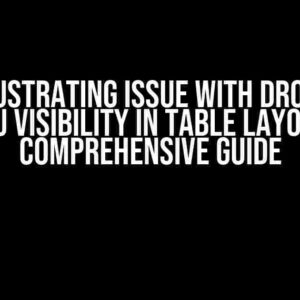Are you tired of dealing with tedious server-side validation in your Blazor applications? Look no further! Client-side validation is here to revolutionize the way you handle form validation, and we’re excited to take you on this journey. In this article, we’ll delve into the world of Blazor client-side validation, exploring its benefits, how it works, and providing step-by-step instructions to get you started.
Why Client-Side Validation Matters
- Improve user experience by providing instant feedback
- Reduce the load on your server by minimizing unnecessary requests
- Enhance security by catching errors before they reach your server
- Implement complex validation logic with ease
Blazor Client-Side Validation: The Basics
Blazor, being a modern web framework, comes with built-in support for client-side validation. The framework uses a combination of HTML, C#, and JavaScript to provide a seamless validation experience.
At its core, Blazor client-side validation relies on the `System.ComponentModel.DataAnnotations` namespace, which provides a set of attributes that can be applied to your model properties to define validation rules. These attributes are then used by the Blazor framework to generate the necessary JavaScript code to perform validation on the client-side.
Supported Validation Attributes
Blazor supports a range of validation attributes, including:
- [Required]
- [StringLength]
- [RegularExpression]
- [Range]
- [EmailAddress]
- [Phone]
- [Url]
- [CreditCard]
- [FileExtensions]
These attributes can be combined to create complex validation rules, and can be applied to both primitive types and complex objects.
Configuring Client-Side Validation in Blazor
To enable client-side validation in your Blazor application, you’ll need to follow these simple steps:
- Add the `@using System.ComponentModel.DataAnnotations` directive to your Razor component
- Apply validation attributes to your model properties
- Use the `EditForm` component to wrap your form elements
- Use the `DataAnnotationsValidator` component to enable client-side validation
Here’s an example of how your code might look:
<@using System.ComponentModel.DataAnnotations>
<EditForm Model="@myModel" OnSubmit="@HandleSubmit">
<DataAnnotationsValidator/>
<div>
<label>Name:</label>
<InputText @bind-Value="myModel.Name" />
<ValidationMessage For="@(() => myModel.Name)" />
</div>
<button type="submit">Submit</button>
</EditForm>
Customizing Validation Messages
By default, Blazor will display the standard error messages for each validation attribute. However, you can customize these messages to fit your application’s needs.
To do this, you can use the `ValidationMessage` component and pass a custom message as a parameter:
<ValidationMessage For="@(() => myModel.Name)">
<span>Please enter a valid name</span>
</ValidationMessage>
Advanced Client-Side Validation Techniques
Custom Validation Attributes
Blazor allows you to create custom validation attributes by inheriting from the `ValidationAttribute` class. This can be useful when you need to implement complex validation logic that isn’t covered by the standard attributes.
Here’s an example of a custom validation attribute that checks if a string is a valid hexadecimal color code:
public class HexColorAttribute : ValidationAttribute
{
public override bool IsValid(object value)
{
var hexColor = (string)value;
return hexColor.StartsWith("#") && hexColor.Length == 7;
}
}
Model-Level Validation
In addition to property-level validation, Blazor also supports model-level validation. This allows you to validate the entire model, rather than individual properties.
Model-level validation can be achieved by creating a custom validation attribute that inherits from the `ValidationAttribute` class and overrides the `IsValid` method:
public class ModelValidationAttribute : ValidationAttribute
{
public override bool IsValid(object value)
{
var model = (MyModel)value;
return model.Name != null && model.Age > 18;
}
}
Common Scenarios and Solutions
While Blazor client-side validation is a powerful tool, it’s not without its challenges. Here are some common scenarios and solutions to help you overcome them:
Scenario 1: Validating Complex Objects
Problem: You have a complex object with nested properties that need to be validated.
Solution: Use the `ValidateComplexType` attribute to enable validation for complex objects.
public class Address
{
[Required]
public string Street { get; set; }
[Required]
public string City { get; set; }
[Required]
public string State { get; set; }
[Required]
public string Zip { get; set; }
}
public class User
{
[Required]
public string Name { get; set; }
[ValidateComplexType]
public Address Address { get; set; }
}
Scenario 2: Validating Arrays and Collections
Problem: You have an array or collection of objects that need to be validated.
Solution: Use a custom validation attribute that iterates over the collection and validates each item individually.
public class ValidateArrayAttribute : ValidationAttribute
{
public override bool IsValid(object value)
{
var array = (string[])value;
foreach (var item in array)
{
if (string.IsNullOrEmpty(item))
return false;
}
return true;
}
}
Conclusion
Client-side validation is an essential aspect of modern web development, and Blazor provides a robust and flexible framework for implementing it. By mastering the techniques outlined in this article, you’ll be able to create robust and user-friendly applications that provide instant feedback and enhance the overall user experience.
Remember to stay tuned for more articles on Blazor and its ecosystem, and don’t hesitate to reach out if you have any questions or need further assistance.
| Validation Attribute | Description |
|---|---|
| [Required] | Specifies that a property is required |
| [StringLength] | Specifies the minimum and maximum length of a string property |
| [RegularExpression] | Specifies a regular expression pattern to match |
| [Range] | Specifies a range of values for a numeric property |
| [EmailAddress] | Specifies that a property should be a valid email address |
| [Phone] | Specifies that a property should be a valid phone number |
| [Url] | Specifies that a property should be a valid URL |
| [CreditCard] | Specifies that a property should be a valid credit card number |
| [FileExtensions] | Specifies that a property should be a valid file extension |
Resources
For more information on Blazor client-side validation, we recommend checking out the following resources:
- Microsoft Docs: Blazor Client-Side Validation
- Blazor Official Website: Client-Side Validation
- Stack Overflow: Blazor Client-Side Validation
Here are 5 Questions and Answers about “Blazor Client Side Validation” with a creative voice and tone:
Frequently Asked Questions
Get the scoop on Blazor Client Side Validation and harness the power of seamless form validation!
What is Blazor Client Side Validation?
Blazor Client Side Validation is a feature in Blazor that enables you to validate form data on the client-side, providing instant feedback to users without requiring a round trip to the server. It’s like having a superhero sidekick that saves the day, one validation at a time!
How does Blazor Client Side Validation work?
Blazor Client Side Validation uses a combination of C# and JavaScript to validate form data in real-time. When a user interacts with a form field, the validation rules are executed on the client-side, and the results are displayed instantly. It’s like having a magic wand that makes validation disappear… err, appear!
What are the benefits of using Blazor Client Side Validation?
The benefits are many! Blazor Client Side Validation reduces the load on your server, improves user experience, and provides instant feedback. It’s like having a superpower that makes your forms faster, more efficient, and more user-friendly!
Can I customize the validation messages in Blazor Client Side Validation?
Absolutely! You can customize the validation messages to fit your brand’s voice and tone. Use the `ValidationMessage` component to display custom error messages that are both informative and friendly. It’s like putting a personal touch on your validation messages!
Is Blazor Client Side Validation compatible with existing validation libraries?
Yes, Blazor Client Side Validation is designed to work seamlessly with popular validation libraries like System.ComponentModel.DataAnnotations and FluentValidation. You can use these libraries alongside Blazor Client Side Validation to create a robust and comprehensive validation system. It’s like having the best of both worlds!




